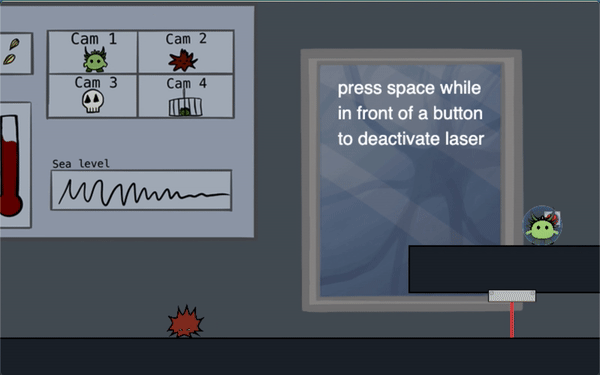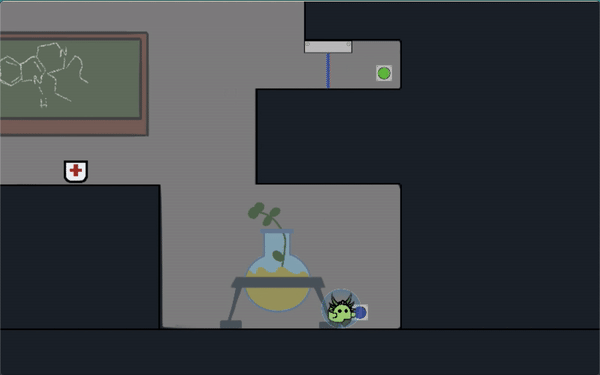Forever Aloe title screen
Forever Aloe is a team project I created with Annabel Maokhamphiou and Raquel Ramirez. I did the programming and level design for this game. Due to the short timeframe of the project (about four weeks), I quickly prototyped level layouts and puzzle designs and I engineered a solution to a broken level map editor tool.
Forever Aloe is a puzzle platformer, so I designed some simple lock-and-key puzzles for players to overcome. In order to teach players about our implementation of this mechanic (using lasers and buttons of matching colors), I placed the first laser/button pair such that both would be on-screen when the button was pressed. Then, in the next level when there are multiple laser/button pairs, I placed the first different-looking pair such that they were both on-screen when the corresponding button was pressed.
Introducing the Laser-Button Mechanic
Since this is the first time players encounter buttons and lasers in the game, there is some text explaining which button to press. The button and laser are situated such that when the player presses the button and removes the laser, they will see the laser disappear immediately.
Iterating on the Laser-Button Mechanic
In the next level, the player can either explore the level or run to each button. Since I iterated on the puzzle design and the player can take multiple paths through the level, I placed two separate buttons in a similar way to the first one.
The blue button and laser can be found if the player moves to the right first. When they press the blue button, they will see the blue laser turn off directly above them.
If they choose to head up, they can encounter the purple laser and button. Just like the blue button, they can see the corresponding laser turn off when the button is pressed.
Placing two versions of the same lesson accounts for variations in play style and ensures that players are given adequate in-game examples of mechanics for them to learn the rules of the game world.
Double Jumping
Double jumping is a common mechanic in platformer games, but not all players are aware of this. I designed the first obstacle presented to the player to be just too tall for them to jump over. Since the only instructions that they are offered relate to movement and the shield, they are subtly encouraged to experiment with the controls. This naturally prompts them to try double jumping, which is then used to navigate the second level.
Level Draft
I designed this level to iterate on our lock-and-key puzzles. Each lock (color-specific laser barrier) has a corresponding key (color-specific button), which is denoted by the plus marks. I also used a numbering system so that we knew which tile asset was needed for each tile in the map.
Level Draft
Below are screenshots of my tile map solution. Essentially, I hard coded each tile’s position in the 1280x2624 pixel level map. This allowed me to build the whole level by reusing twelve tile assets, instead of asking my partners to make a lot of separate environment art pieces. This allowed for more prototyping of the level design without giving the artists extra work because all I needed to do to tweak the level design was change where I placed a tile in the function I call to build the level.
While this left the game with some weird physics interactions, this engineered solution allowed the whole team to focus more on other aspects of the game, like creating more art assets and adding more mechanics.







